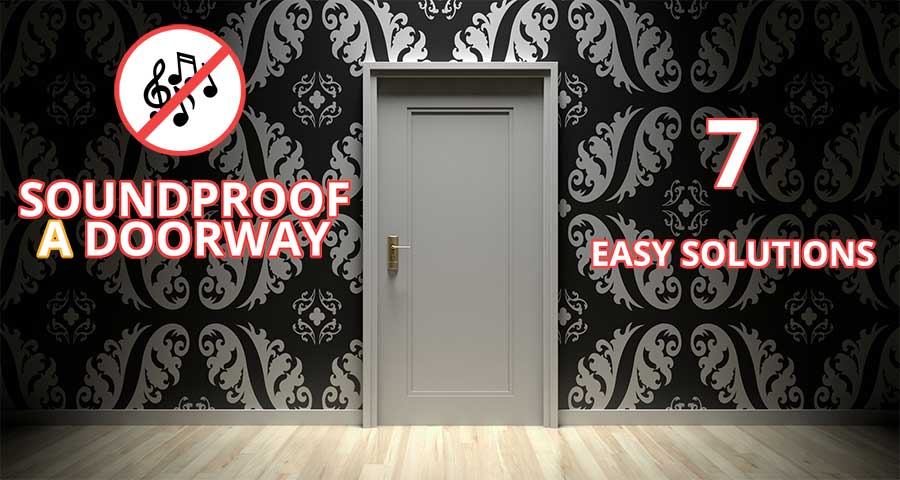Did you know that doorways are the biggest offender when it comes to noise? Most doors in homes today are hollow and there are all kinds of ways for sound to get through.
Luckily, there are a number of easy steps you can take to soundproof your doorways. Doing even just one or two of these steps will make a big difference and some of them are surprisingly inexpensive.
1. Apply weatherstripping tape or door gaskets.
You hopefully don’t have a need to block out wind on any interior doors in your house but weatherstripping can also block out sound. Get some self-adhesive weatherstripping tape and firmly apply it all along the door frame.
Your goal is to create compression, where the door will compress against the weatherstripping with a tight seal. This will help block noise.
Weatherstripping tape is a very affordable solution but if you’re willing to spend just a bit more for a more professional solution, you can try installing door gaskets.
If you’re not very comfortable with DIY projects, you might want to find a handy friend to help you out with this project. It’s not super difficult but you do want to get everything aligned perfectly. Door gaskets will just help you get an even tighter seal than you can get with weatherstripping tape.
2. Install a door sweep.
Weatherstripping takes care of all the small cracks around the edges of the door but it doesn’t deal with the biggest crack of all. That’s where a door sweep comes in.
This simple product seals the gap between the bottom of the door and the floor. A whole lot of noise can get in through that crack and a door sweep stops that noise in its tracks.
Although cheap door sweeps do the job remarkably well, you can get even better results with a more high-tech door sweep. This automatic door sweep uses a spring mechanism to automatically lower the seal down to the floor when the door is closed. It’s a bit more expensive but it eliminates the drag you get with a cheaper door sweep.
3. Reinforce the door with a soundproof blanket.
Another option is to reinforce your hollow door with a soundproofing blanket. This heavy blanket will soak up a lot of sound thanks to its fiberglass panel.
This does a great job but it might not fit your design aesthetic perfectly. I recommend using it for rooms that you don’t care as much about how they look, like the laundry room or the bathroom.
You can also just make it easy to take the blanket down when you want your room to look especially nice. By installing some heavy duty hooks with anchors above the door, you can easily remove the soundproofing blanket when you want to.
Sometimes you might want to be able to hear more easily what is going on outside your door, for example, so you might want to reserve the soundproofing blanket for only when you really need quiet. Hanging the blanket from strong hooks like this gives you a lot of flexibility.
4. Add soundproofing foam panels.
If you don’t want to spend the money to get a soundproofing fiberglass blanket, you can use more affordable soundproof foam panels instead. A 12-pack of some basic acoustic foam panels is really reasonably priced and it will help to minimize noise to a certain extent.
Your home probably won’t get featured in an interior design magazine with these on your doors but it is possible to arrange them in a cool pattern.
To hang the foam panels on your door without risk of damaging the door, you should use Command Strips. These are incredibly easy to use and they won’t damage the door at all.
If you don’t like the look of traditional soundproofing foam panels, you can try installing a single large acoustic panel on the back of the door.
These are covered in a textured fabric and can look like a cool art statement on the back of the door. In addition to looking nice, they will do wonders for absorbing sound. They have a noise reduction coefficient score of 1 out of 1 so it really doesn’t get much better.
5. Dampen the sound on the other side of the door.
A doorway is really just a conduit for sound. It is not the source of the noise but it’s almost like it has an open-door policy for any and all sound.
While there are many things to do directly to the doorway to reduce that sound, one of the easiest things to do is to deal with the source of the noise near the doorway.
Adding a rug is one of the easiest solutions. A rug obviously won’t be able to turn off the noise altogether but it can help to dampen it quite a bit.
This is because, with hard floors, sound just bounces around. It has a lot of things to reflect off of, from the floor to the walls to the ceiling and back. There is nothing to absorb any of the sound. There are some really great looking rugs available at surprisingly affordable prices.
You can freshen up your look while you’re working to reduce the overall noise level. Another way to dampen sound near a doorway is to add something like bookshelves or other furniture on either side of the doorway. This will help to absorb a lot of sounds as well.
6. Consider adding curtains.
In a bedroom, you might want to soundproof a doorway to help improve sleep quality. Light sleepers tend to be bothered by even small amounts of noise. Curtains or drapes are normally reserved for windows but there’s no reason you can’t install some on your door.
Some nice soundproofing curtains will do a lot to reduce the amount of noise that can get through a doorway.
You will need to install a curtain rod up above your door frame. You can then use the drapes just like you would on a window. Close them to cover the door for those times you want to be sure to block out as much noise as possible.
A big bonus to heavy curtains like these is that they do more than just dampen sound. They will also block out any light and can even trap heat because of their insulation. You can choose any color for your curtains so you can really make this somewhat unusual idea work as part of any room’s design.
7. Buy a new door.
This is the most expensive thing you can do but it could make a huge difference. Your door is probably hollow. This means it is essentially a sound amplifier.
A solid door with more mass will absorb and dampen sound instead of letting it through or amplifying it like a hollow core door. These doors are a lot heavier so it will feel strange to open and shut it at first but the noise reduction will be apparent immediately. You can expect to spend $75-500 on a new solid door.
If you don’t want to buy a new door altogether, you can try adding mass to the door. You can do this by attaching a piece of wood or even drywall in the same size as the door. This can be a bit of a project and it might not look beautiful but adding more mass and thickness to a door will do really help block and absorb sound.
Final Words
Doorways are a weak link in a home when it comes to soundproofing. Luckily, you have a number of options for making your doorways strong leaders rather than the source of trouble.
You can spend a lot of money and time on soundproofing your door but you can also do quite a bit for very little cost and minimal effort.
I recommend trying one or two of these steps at a time. You can try one of the cheaper and easier projects first to see how much it helps. If it’s not enough, try another option.
Doing all seven of these steps is probably more than you need.
Almost everyone can benefit from doing at least a few of these. In my experience, once you experience some of the benefits of soundproofing, it can be hard to stop!
Have you ever soundproofed a doorway? Do you have any tips?

